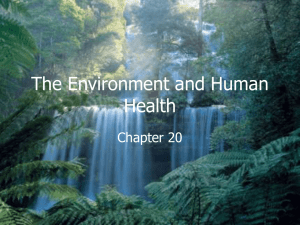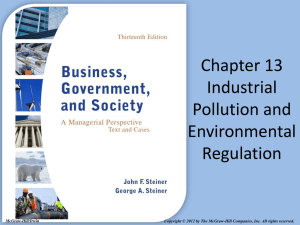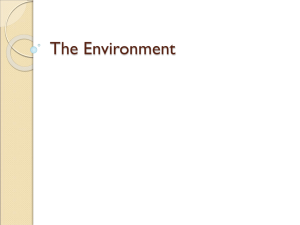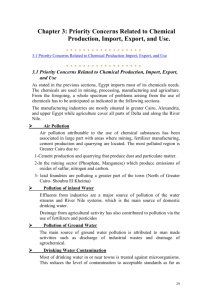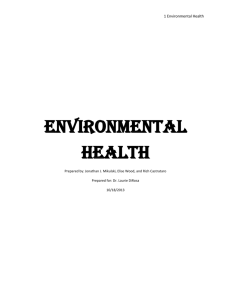Survey - World Health Organization
advertisement
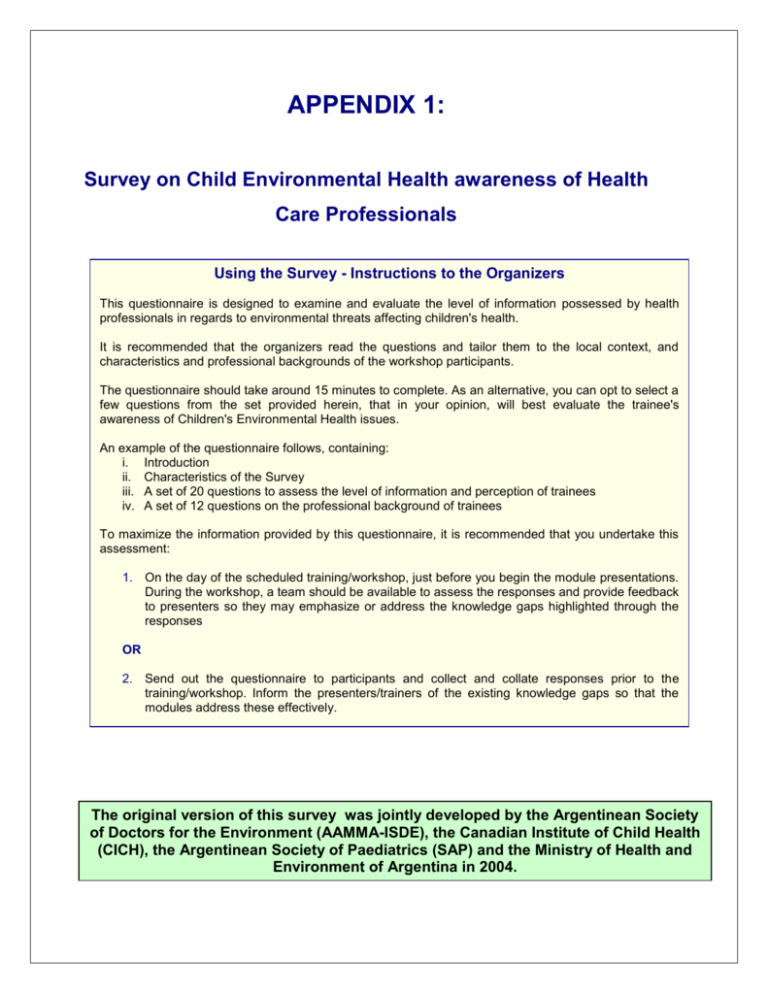
APPENDIX 1: Survey on Child Environmental Health awareness of Health Care Professionals Using the Survey - Instructions to the Organizers This questionnaire is designed to examine and evaluate the level of information possessed by health professionals in regards to environmental threats affecting children's health. It is recommended that the organizers read the questions and tailor them to the local context, and characteristics and professional backgrounds of the workshop participants. The questionnaire should take around 15 minutes to complete. As an alternative, you can opt to select a few questions from the set provided herein, that in your opinion, will best evaluate the trainee's awareness of Children's Environmental Health issues. An example of the questionnaire follows, containing: i. Introduction ii. Characteristics of the Survey iii. A set of 20 questions to assess the level of information and perception of trainees iv. A set of 12 questions on the professional background of trainees To maximize the information provided by this questionnaire, it is recommended that you undertake this assessment: 1. On the day of the scheduled training/workshop, just before you begin the module presentations. During the workshop, a team should be available to assess the responses and provide feedback to presenters so they may emphasize or address the knowledge gaps highlighted through the responses OR 2. Send out the questionnaire to participants and collect and collate responses prior to the training/workshop. Inform the presenters/trainers of the existing knowledge gaps so that the modules address these effectively. The original version of this survey was jointly developed by the Argentinean Society of Doctors for the Environment (AAMMA-ISDE), the Canadian Institute of Child Health (CICH), the Argentinean Society of Paediatrics (SAP) and the Ministry of Health and Environment of Argentina in 2004. Assessing Child Environmental Health Issues as Perceived by Health Care Professionals Example of letter addressed to event participants Dear Colleagues, A number of diseases in children from both rural and urban areas are linked to unsafe and degrading environments. However, many health care providers (HCPs) may be unable to recognize, assess and manage environmentally-related diseases in children. In other instances, health care providers may recognize environmentally-related diseases, but feel that they are not in a position to induce change. How do we address these problems? These problems can be addressed by raising awareness about the importance of the links between environment and health, and enabling those “in the front line” - the health professionals dealing with children and adolescent’s health- to recognize, assess and mitigate or prevent diseases linked to, or triggered by environmental factors. Pediatricians, family doctors, nurses, primary and other health care providers workers, also medical and nursing students, can now be trained on the relationship between children's health and the environment through the use of harmonized, internationally peer-reviewed training materials prepared by WHO in partnership with the International Pediatric Association, selected NGOs and experts from over 15 countries. Such materials and the topics addressed are adaptable to the specific needs of countries and professional groups, and serve as the basis for interaction and dialogue among participants. A one-day …………….. (i.e. two day, three week) training seminar is being held in …………...…….(place), organized by ……………………………………, under the auspices of ………….(Minister of Health and/or Environment, or other) and in collaboration with ……………………………. During this workshop, ……………………(pediatricians, nurses, primary health care workers, environmental officers, etc ) will learn about the harmful effects of air pollution, how and when does exposure to pesticides occur, the effects of different chemicals (depending on modules taught). Moreover, discussions will take place on how health care providers, as well as policy-makers, can work together to help improve the environment for tomorrow’s children. Thank you for your collaboration. 2 SURVEY: Example Questions Section I: Knowledge on Children’s health and environment 1. What information do you have on children’s environmental health issues? [ ] A lot of information [ ] Some information [ ] Little or no information [ ] Not aware of children’s environmental health issues (go to question 4) 2. If you selected, a lot or some information, how did you receive it? (please check all that apply) [ ] Courses/workshops [ ] Conferences [ ] Distance learning [ ] Articles [ ] Magazines [ ] Internet [ ] Other (please specify): _____________ 3. If you selected a lot or some information, on what issues did you receive information? (please check all that apply) [ ] Indoor air pollution (burning of wood and other solid fuels, tobacco smoke, allergens in the household) [ ] Outdoor air quality (air pollution from traffic, waste burning/ incineration, dust and others) [ ] Childhood injuries [ ] Waste disposal [ ] Water pollution (biologic and chemical) [ ] Industrial pollutants [ ] Lead [ ] Mercury [ ] Use of pesticides [ ] Electromagnetic fields [ ] Noise 3 [ ] Food contamination [ ] Mobility and transport [ ] Endocrine disruptors [ ] Other chemicals (please specify): [ ] Other (please specify): ____________________ 4. Are you aware of the association between infant/child exposure to environmental risk factors (exposure to environmental risk factors in the household, school, street, and play areas) and illness? [ ] Yes, please specify how you have become aware:____________________ [ ] No, please specify why:___________________________________________ Section II: Professional Experience 5. When conducting a clinical history, do you gather information about the environment where the child lives, grows, plays and studies? [ ] Frequently [ ] Occasionally [ ] Never [ ] Not applicable 6. How often do you receive questions from parents regarding the following children’s health and environmental issues? (please indicate: 1- often; 2 - sometimes; 3 - never; 0 - I don’t know) [ ] Indoor air pollution (burning of wood and other solid fuels, tobacco smoke, allergens in the household) [ ] Outdoor air quality (air pollution from traffic, waste burning/ incineration, dust and others) [ ] Childhood injuries [ ] Waste disposal [ ] Water pollution (biologic and chemical) 4 [ ] Industrial pollutants [ ] Lead [ ] Mercury [ ] Use of pesticides [ ] Electromagnetic fields [ ] Noise [ ] Food contamination [ ] Mobility and transport [ ] Endocrine disruptors [ ] Other chemicals (please specify): [ ] Other (please specify): ____________________ 7. Based on your experience, which of the following health problems affecting boys and girls could be associated with negative environmental factors? (please indicate: 1- often; 2 - sometimes; 3 - never; 0 - I don’t know) Boys Respiratory illnesses Pre-mature birth Learning disabilities and neurological problems Developmental problems Skin problems Cancer, lymphoma, leukaemia Poisonings Endocrine disruptions Genetic malformations Nutritional problems Unintentional injuries (accidents) Others (please specify):_______________ 5 Girls Section III: Specific environmental risk factors 8. Based on your experience, where are boys and girls most likely to be exposed to chemical environmental hazards? (please indicate: 1- often; 2 - sometimes; 3 - never; 0- I don’t know) Boys Girls Home Streets Recreational areas School Rural areas/farms Parent’s work place Child’s work place Others (please specify):___________ 9. Based on your experience, which of the following indoor air pollutants affect children’s health? (please indicate: 1- often; 2 - sometimes; 3 - never; 0- I don’t know) [ ] Combustion products, (gas, wood and others) [ ] Volatile compounds from household products and solvents [ ] Construction materials (asbestos, dust and others) [ ] Pesticides (insecticides, fungicides, herbicides and rodenticides) [ ] Tobacco smoke [ ] Moulds, animal hair, dust mites, humidity [ ] Others, specify:_____________ 10. Based on your experience, which of the following outdoor air pollutants affect children’s health? (please indicate: 1- often; 2 - sometimes; 3 - never; 0- I don’t know) 6 [ ] Combustion products from traffic (particle matter and exhaust) [ ] Pollutants from industrial activities (heavy metals, volatile chemicals, etc.) [ ] Particles and dust (silos, building material, demolitions and others) [ ] Open burning of garbage [ ] Pesticides (insecticides, fungicides, herbicides and rat poison) [ ] Others (please specify):__________________ 11. Based on your experience, which of the following drinking water pollutants affect children’s health? (please indicate: 1- often; 2 - sometimes; 3 - never; 0- I don’t know) [ ] Biologic contaminants (parasites, bacteria, viruses) [ ] Natural chemical pollution (arsenic and others) [ ] Industrial chemical pollution (mining, chemical waste and others) [ ] Agrochemicals (pesticides and fertilizers) [ ] Others (please specify):__________________ 12. What are the main types of accidents or injuries you see in your line of work? [ ] choking, drowning [ ] falls [ ] burns [ ] poisonings [ ] child abuse/physical punishment [ ] injuries from traffic-related accidents [ ] other, please specify:____________________ Section IV: Actions & priorities 13. What are the top 5 environmental risk factors you feel most influence children’s health in your country? 7 (please rank from each option on a scale of 1 to 5; 1 being highest priority) [ ] Indoor air pollution (burning of wood and other solid fuels, tobacco smoke, allergens in the household) [ ] Outdoor air quality (air pollution from traffic, waste burning/ incineration, dust and others) [ ] Childhood injuries [ ] Waste disposal [ ] Water pollution (biologic and chemical) [ ] Industrial pollutants [ ] Lead [ ] Mercury [ ] Use of pesticides [ ] Electromagnetic fields [ ] Noise [ ] Food contamination [ ] Mobility and transport [ ] Endocrine disruptors [ ] Other chemicals (please specify): [ ] Other (please specify): ____________________ 14. Based on your experience, which of the following actions are relevant in protecting children from environmental hazards? (please indicate: 1- often; 2 - sometimes; 3 - never; 0- I don’t know) [ ] Revealing the type and magnitude of specific environmental problems [ ] Developing epidemiological environmental studies [ ] Developing training materials for future physicians [ ] Encouraging government action through advocacy [ ] Legislative action/Policy development [ ] Community interventions aimed at eliminating a risk factor [ ] Involvement of the media to raise awareness [ ] Infrastructural/service delivery changes (improving public transportation system, [ ] Raising community awareness through information and communication activities [ ] Including the topic as part of the school curriculum [ ] Encouraging cooperative interdisciplinary and participative intersectoral networks 8 [ ] Others (please specify):____________________ 15. Please rank each action in order of importance (1 being most important) [ ] Revealing the type and magnitude of specific environmental problems [ ] Developing epidemiological environmental studies [ ] Developing training materials for future physicians [ ] Encouraging government action through advocacy [ ] Legislative action/Policy development [ ] Community interventions aimed at eliminating a risk factor [ ] Involvement of the media to raise awareness [ ] Infrastructural/service delivery changes (improving public transportation system, [ ] Raising community awareness through information and communication activities [ ] Including the topic as part of the school curriculum [ ] Encouraging cooperative interdisciplinary and participative intersectoral networks [ ] Others (please specify):____________________ 16. What are the three main areas of improvement/support you feel your country has in the area of children’s environmental health? [ ] research and epidemiology [ ] professional training [ ] clinical trials [ ] educational and prevention campaigns [ ] experimental research [ ] raise awareness among local authorities [ ] information/documentation in country language [ ] other, please specify:______________________________ 17. Are you a member of a professional society or affiliation in your country? [ ] Yes [ ] No (skip to question 20) 9 18. What kind of activities or actions on children’s environmental health has your society carried out so far? [ ] taken a public position on the topic [ ] offered training [ ] information dissemination [ ] put prevention activities in place [ ] provided materials in country language [ ] other activity or action, please specify:____________________ [ ] don’t know 19. Based on your experience, which of the following actions could be applied by your regional society or affiliation ? (please indicate 1 - very important; 2 - somewhat important; 3 - not important; 0 - I don’t know) [ ] Revealing the type and magnitude of specific environmental problems [ ] Developing epidemiological environmental studies [ ] Providing professional training in children’s environmental health [ ] Developing training materials for future physicians [ ] Encouraging Government Advocacy [ ] Improving community awareness through information and communication activities [ ] Including the topic as part of the school curriculum [ ] Encouraging cooperative interdisciplinary and participative intersectoral networks [ ] Others (please specify):_____________________ 20. Do you know of any activities that are being carried out in your region concerning the environment and children’s health? Yes [ ] No [ ] If Yes, please provide a description of the activity and contact information below: 10 Section V: Professional Profile 1. Age: ____ years 2. Sex: Male [ ] Female [ ] 3. How many years have you been involved with children's health: _____ years 4. Do you have a pediatric subspecialty: YES [ ] NO [ 5. Major Area of Practice: ] Urban [ ] Rural [ ] 6. Province/city where you live: _______________________ 7. Where do you work the majority of the time? [ ] Public (government hospitals, centers of primary attention, etc.) [ ] Private (offices, clinics, house calls, etc.) 8. Where do you treat the majority of your patients? [ ] In hospital [ ] Outside of the hospital (ambulatory) 9. Within which age group do the majority of you patients fall: [ ] <1 year [ ] 1-5 years 11 [ ] 6-12 years [ ] 13-18 years [ ] All ages [ ] I don’t know 10. How would you describe the majority of your patients in terms of socioeconomic background? [ ] Low [ ] Middle [ ] High 11. Your Regional Society or Affiliation: ________________________ 12. Would you like to be part of a network on children’s health and environment as a future trainer? [ ] YES [ ] NO Thank you for taking the time to complete this survey and for your ongoing commitment to improving the health of children! 12






